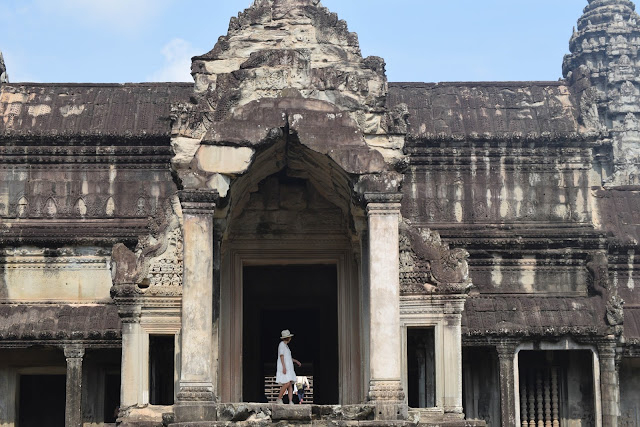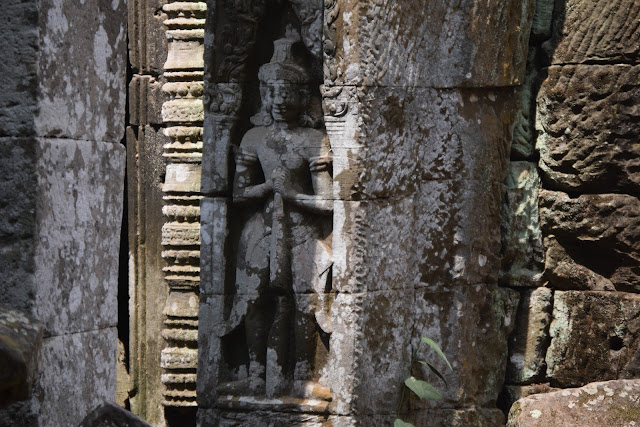We've all heard of Angkor Wat in Cambodia, right! It's one of the reasons I chose to come here following my trip to Laos. I didn't anticipate how difficult it would be to move from one journey to the next, without a break to process my experiences. I had flown back from Vientiane, Laos, to Bangkok on Wednesday April 26th and met up with the new tour group that same night. A bus trip to Siem Reap, Cambodia, the following day (Thursday) set us up for our visit to Angkor Wat.
So, it was my first full day in Cambodia and like it or not, the plan was to be up at 4:45 am to experience the magical sunrise at Angkor Wat with my new companions on my second Intrepid tour! Being the troopers we are, up we got and off we went into the darkness. Much to my surprise, this special experience is sought after by many others, so the place was bustling when we got there.
I offer this photo to temper any 'ahhh' reactions about the first photo of the famous temple. The first photo was facing front - this one - same spot, just a 90 degree turn! Perspective and framing is everything is it not? No this was not a serene, meditative experience!
Our guide 'Johnny Walker' pointed out the best places to get pictures with the reflections in the water. Being dry season, I have to confess to you that the water was a muddy mess - but looking at the picture, you don't need to know that, do you!
I guess I didn't realize that Angkor Wat is just ONE of the temples in the complex that bears its name. I also didn't appreciate the fact that it, along with the many other temples in the park, is the largest religious monument in the world, dating from the 9th to the 15th century. As a result, UNESCO has put its 'World Heritage' stamp on the area, which in general is a good thing. Buying a ticket felt a bit like Disney with the crowd management and speed of processing, but after that, because there are so many temples, it was not so much of a crush except at the most popular - like Angkor Wat itself and Ta Prohm where Angelina Jolie filmed 'Tomb Raiders'.
Angkor Wat itself was originally built as a Hindu temple, but in later years was layered over with Buddhist features. The extent of the rest of the development was rediscovered in the 16th century when one of the Khmer (Cambodian) kings found them on a hunting trip. However, discoveries of new temples buried in the forest are still occurring today with satellite imagery.
At present there are at least 50 sites in the archaeological park,with additional temples further away. Clearly to see it all, one would need weeks! We visited in turn, Angkor Wat, Ta Prohm, Bayon, the Elephant Terrace and Bakong.
Angkor Wat itself was never abandoned to the elements and has been in continuous religious use since it was finished in 1152. According to inscriptions, the construction of Angkor Wat involved 300,000 workers and 6,000 elephants. The stones were floated down the river on rafts from a quarry 50 km away.
Although I could do lots of research and go to great lengths to tell you history and features about each of these sites, I suspect that it would be wasted energy, as that was not the point of it all for me. I appreciated just the beauty of the stones speaking for themselves.
The central tower was built with very steep and difficult steps, symbolizing the struggle that it takes to get to heaven, as they believed that God was at the top of the 'mountain'. This 'stairway to heaven' is inclined at nearly 70%. The original, stone steps were used by the King for ceremonial purposes. I was glad they put wooden steps over the top - but they were still very steep!
The detailed carvings on the walls were very beautiful. Fortunately they could not be removed, whereas a lot of the other art work has been stolen or removed to museums.
Graffiti has also been a problem over the years.
Many of the Chinese and Japanese tourists wore fabulously photogenic clothing in order to capture beautiful images of themselves in this unique setting. They were very clever at coming up with some very cute set-ups. I liked this woman's white dress and sassy hat!
From Angkor Wat itself, we moved on to Ta Prohm, the temple where the movie 'Tomb Raiders' was filmed.
It presents a conservation dilemma as you see, because the trees are growing right out of it. At this point in time, they are leaving the trees, as they lend so much to the character of the temple, however, they also carry the seeds of its destruction.
Much of the temple is still a mess of rubble. We had to walk on set pathways and were not free to roam. Conservation work was going on at many places.
The roots of the enormous fig trees relentlessly snake their way through the structures.
Nooks and crannies hold hidden treasures.
It was such a perfect setting for a movie, I had to shake myself to remind me it was not a Disney construct!
Following this, our third temple was Bayon, which turned out to be one of my favorites.
Our temple guide, who called himself 'Johnny Walker' proved to be a great photographic consultant, too and showed us how to use our panoramic mode to get us 'in the picture' twice! It was great fun.
Bayon, unlike Angkor Wat, was built as a Buddhist Temple right from the outset in the late 12th Century. It was one of the last to be built. At different periods of history it my have been used as a Hindu temple - but it started out as Buddhist.
It also had steep steps to enter.
It was crowded, too.
Its most distinguishing feature is the many serene stone faces on its towers - 216 faces in total. Scholars are not sure if the faces are of the king who built the temple, or if they represent Buddha. Whichever, they were very pleasing to look at.
One interesting detail our guide pointed out was this very small carving - in a door lintel - of a creature that looks very much like a stegosaurus! This was carved long before we had palaentologists I think!
Finally - lunch, and then made our way to the final temple, Bakong, which was one of the earliest to be built in the late 9th century. It was a combination of brick and sandstone and our guide said they stopped using brick in later temples because it did not hold carvings as effectively as the sandstone does.
Lion statues guard the stairway to the central pyramid.
You can see how the bricks crumble more than the sandstone.
There was superb carving on the doors. You can see the lions on either side here, too.
Definitely a different 'feel' to it.
As with my other experiences here, I am very grateful to have seen this for myself. It is however, worth noting that these structures are evidence of a civilization that was highly developed and sophisticated up to about 600 years ago. Today Cambodia is a nation that has had significant political problems in modern times, not to mention economic challenges. Let us not be too certain about the sustainability of our own world, lest it too end up as rubble or structures of uncertain purpose
reclaimed from the grips of Mother Nature in millennia to come!































No comments:
Post a Comment